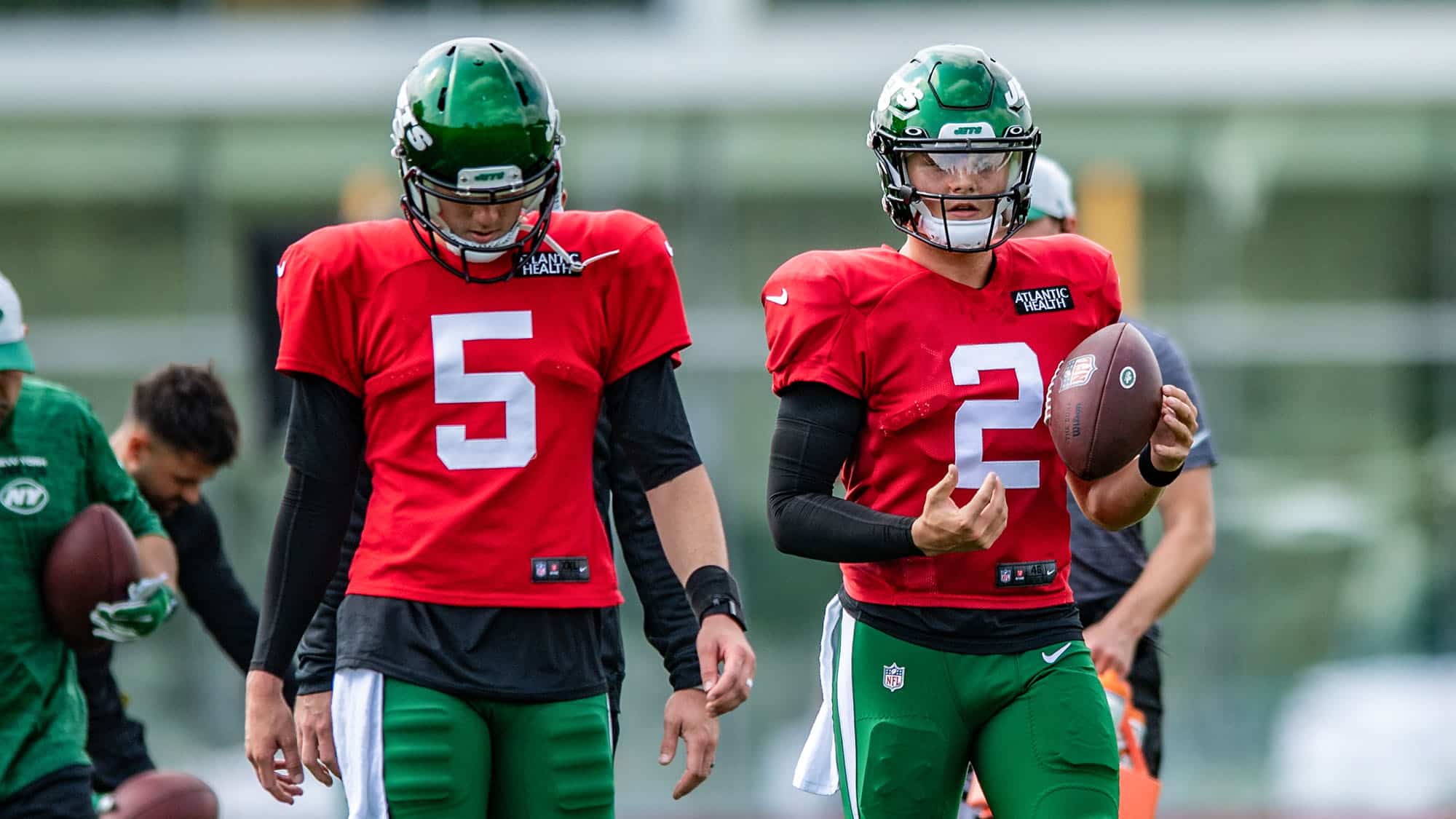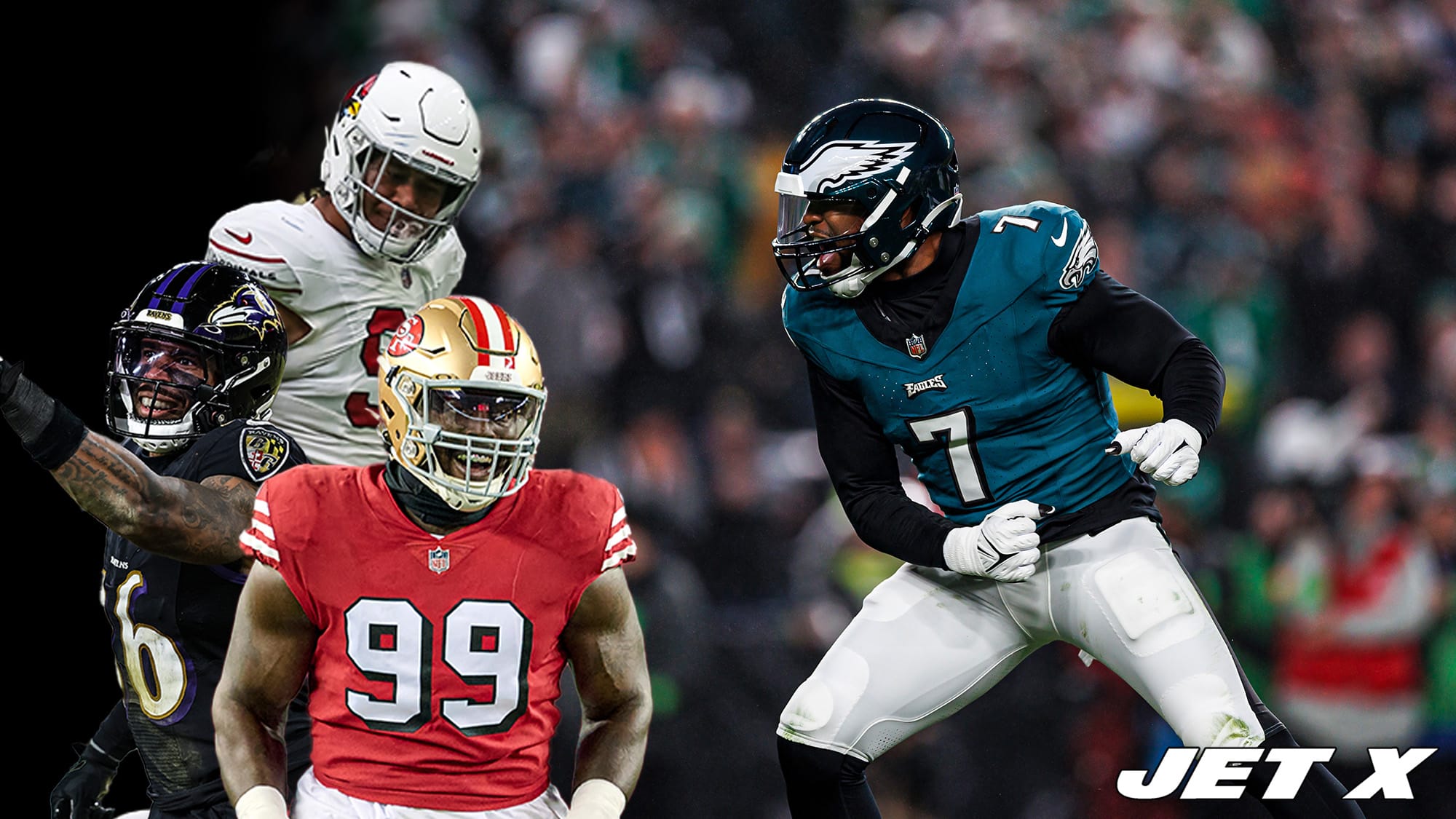How well did Zach Wilson and Mike White perform against the New England Patriots beyond the box score?
Throughout the 2021 season, I will be running a weekly series of breakdowns in which I analyze Zach Wilson‘s performance (and that of any other Jets quarterback) by grading every single one of his plays on a 0-to-10 scale.
My goal with this grading system is to capture the true quality of Wilson’s performance. Box score statistics can be misleading, as they do not account for a variety of factors that determine whether a quarterback performed well or poorly on a given play.
After re-watching each play on the All-22 film, I grade them on a 0-to-10 scale and then take the average of all plays to form a 0-to-100 overall score with 50 being approximately league-average (based on my studying of numerous other quarterback performances across the league).
Here are just a handful of the primary factors that are taken into account in the grading of each play, and a basic description of what I’m looking for:
- Decision-making (Did the QB choose the best available option or did he leave a better play on the field?)
- Throw difficulty (Clean pocket or pressured? Wide open or tight window? Stationary or on the move? More difficult throws are more valuable.)
- Accuracy/placement (Even if the pass is completed, was the ball placed in the best possible spot or did the receiver have to make an extra effort to catch it?)
- Game situation – score, time, field position, down and distance (Good decisions based on the clock/situation are crucial. Playing the sticks is also important – it is not a good play to throw a 5-yard out on third-and-10 while a 15-yard dig is open, but a 5-yard out on third-and-2 is good.)
Ultimately, it’s all about context. Not all 40-yard completions are created equal. Not all interceptions are created equal. You need to watch a play to understand whether the quarterback did a good or bad job. The raw result of a play cannot give you that answer.
When we analyze every play on film multiple times and grade the quarterback’s individual effort independent of his surroundings or the on-paper outcome of the play, we get a much better estimation of how well he actually played.
Of course, keep in mind that these grades are subjective. They are but one man’s opinion and are not gospel. Feel free to let me know your takes on my grades for Wilson’s performances.
Let’s dig into everything that went into my 0-to-100 grades for Wilson’s short appearance against the Patriots and Mike White’s performance in relief.
Glossary
For each performance, I include a few metrics that help explain how Wilson arrived at his final grade.
These are some of the metrics I will break down for every Wilson outing.
Overall grade: 0-to-100 grade based on the average score of all plays analyzed. An estimation of individual performance quality.
Positive plays: Number of plays graded above 5.0: above-average efforts.
Negative plays: Number of plays graded below 5.0: below-average efforts.
Neutral plays: Number of plays graded as a 5.0: plays that are not noticeably good or bad. These are typically lost plays or plays in which the QB can hardly be evaluated: screens, batted passes, miscommunications, and unavoidable sacks are commonly graded as a 5.0.
Positive/negative ratio: Ratio of positive plays to negative plays. Defines the quarterback’s consistency level.
Average positive score: The average score of all positive plays. An indicator of how high the quarterback’s peaks were — a higher score indicates his best plays were typically highlight-reel-worthy while a lower score indicates that his best plays got the job done, but were typically unspectacular.
Average negative score: The average score of all negative plays. An indicator of how low the quarterback’s valleys were — a higher score indicates his mistakes were typically minor while a lower score indicates that his mistakes were typically brutal.
Wow Factor: Combination of average positive and average negative. An indicator of the combined ability to avoid big mistakes and produce jaw-dropping moments.
7+ plays: Number of plays graded 7.0 or better: elite moments.
≤3 plays: Number of plays graded 3.0 or worse: brutal moments.
Zach Wilson vs. New England Patriots
- Actual stats: 6/10 for 51 yards, 0 TD, 0 INT (5.1 Y/A, 73.3 QB rating). 1 sack for 8 yards.
- Overall grade: 41.7 – (Average: 50, Great: 60+, Elite: 70+, Poor: <40, Bad: <30)
- Plays graded: 12
- Neutral plays: 2
- Positive plays: 5 (41.7%) – (Average: 50%, Phenomenal: >60%, Poor: <40%)
- Negative plays: 5 (41.7%) – (Average: 30%, Phenomenal: <20%, Poor: >40%)
- Positive-negative ratio: 1.00 – (Average: 1.70, Phenomenal: 3.00+, Poor: <1.00)
- Average positive: 6.00 – (Average: 5.90, Phenomenal: 6.00+, Poor: <5.80)
- Average negative: 3.85 – (Average: 3.80, Phenomenal: 4.00+, Poor: <3.60)
- Wow factor: 9.85 – (Average: 9.70, Phenomenal: 10.00+, Poor: <9.40)
- 7+ plays: 1 (8.3%) – (Average: 8%, Phenomenal: >12%, Poor: <4%)
- ≤3 plays: 1 (8.3%) – (Average: 8%, Phenomenal: <4%, Poor: >12%)
I scored Wilson with a 41.7 overall grade for his performance against the Patriots. That ranks as his third-best performance out of six games this season, finishing well ahead of his sloppy games against the Patriots (22.6) and Falcons (23.0) and behind his performances against the Titans (53.6), Panthers (51.1), and Broncos (46.4). Wilson’s season grade sits at 39.5.
We saw much of the same ups and downs from Wilson in his short appearance. On the positive side, he flashed his improvisational ability with a beautiful in-stride flip-pass to Ty Johnson and a perfectly accurate third-down laser to Ryan Griffin while rolling to his left.
Negatively, Wilson made a handful of questionable decisions.
There were back-to-back easy gains that he missed to open the Jets’ second drive. Wilson locked onto a deep read for too long and got the ball out to Corey Davis in the flat too late, leaving Davis with not enough room to make the catch in-bounds and thus missing an easy first-down gain. Then, Wilson misfired on an easy throw to Jamison Crowder in the flat while being forced to his right by the pressure.
Later, Wilson immediately tried to hit Elijah Moore on a comeback route short on third down, and the throw was fine (Moore slipped on the break to create an incompletion), but Moore would have been well short of the sticks anyway. Meanwhile, Corey Davis had the leverage on his defender to separate over the middle on a dig route for a first down if Wilson scanned the field longer and looked for him.
The play on which Wilson got hurt was a bomb for Keelan Cole that drew a 46-yard pass interference. It was a bad decision and a bad pass.
Wilson had his eyes on Ty Johnson for an easy pass into the flat that would have likely been a first down, but as he sensed a rusher bearing down, Wilson instinctively turned his head deep and chucked the ball to Cole.
There was a small window open for the ball to drop into Cole’s arms, so it was an understandable attempt (and great anticipation to know it would be there, as Cole was not open at all when Wilson threw the ball), but Wilson missed badly to the inside. A Patriots defender dropped what should have been an easy interception.
Wilson is all over the place right now. Sometimes, he is not willing enough to take the checkdown. Other times, he is too quick to take it. Worst of all, he is not even perfectly accurate on those short throws.
Perhaps a few weeks of watching from the sidelines will do Wilson some good.
Mike White vs. New England Patriots
- Actual stats: 20/32 for 202 yards, 1 TD, 2 INT (6.3 Y/A, 64.8 QB rating). 1 sack for 8 yards.
- Overall grade: 34.8 – (Average: 50, Great: 60+, Elite: 70+, Poor: <40, Bad: <30)
- Plays graded: 34
- Neutral plays: 3
- Positive plays: 14 (41.2%) – (Average: 50%, Phenomenal: >60%, Poor: <40%)
- Negative plays: 15 (44.1%) – (Average: 30%, Phenomenal: <20%, Poor: >40%)
- Positive-negative ratio: 0.93 – (Average: 1.70, Phenomenal: 3.00+, Poor: <1.00)
- Average positive: 5.78 – (Average: 5.90, Phenomenal: 6.00+, Poor: <5.80)
- Average positive: 3.88 – (Average: 3.80, Phenomenal: 4.00+, Poor: <3.60)
- Wow factor: 9.66 – (Average: 9.70, Phenomenal: 10.00+, Poor: <9.40)
- 7+ plays: 2 (5.9%) – (Average: 8%, Phenomenal: >12%, Poor: <4%)
- ≤3 plays: 3 (8.8%) – (Average: 8%, Phenomenal: <4%, Poor: >12%)
Mike White will be a downgrade compared to Zach Wilson if he maintains the level of performance I saw from him in New England. His 34.8 grade is worse than Wilson’s season grade of 39.5.
We saw two different Whites in this game: the pre-interception White and the post-interception White.
Before throwing his first interception with 4:16 to go in the third quarter, White was pretty darn good. I had him with a grade of 80.0 over his first 15 plays. Wilson has only had one 15-play run better than that this season: a second-half stretch against the Panthers in which he hit a blistering 82.6.
Starting with his first interception, White was terrible. I hit him with a grade of -0.8 over his final 19 plays.
White was sharp to kick things off. While he was a bit over-conservative, his accuracy was sublime. A tremendous back-shoulder touchdown to Corey Davis and a smooth lob pass to Jamison Crowder on a fade were the highlights.
On the interception, White overshot an open Ryan Griffin over the middle, missing way too high. His accuracy fell off a cliff from that point.
Out-breaking routes were a problem. White consistently placed balls too far inside.
When receivers were wide open on easy throws into the flat, White would miss late-and-behind, getting them hit and leading to incompletions. Keelan Cole and Elijah Moore were victims of this.
For his second interception, White tried to squeeze the ball to Moore on an out route but left it too far inside, giving J.C. Jackson a window to make a play on it.
White did a poor job of reading the field, consistently releasing the ball in an instant based on his pre-snap read and missing better options.
Most notably, on a fourth-and-4 play, White identified Trevon Wesco with a man-to-man matchup on a drag route and locked onto him post-snap. A blitzing linebacker dropped out of his rush and deflected the pass. Meanwhile, Jamison Crowder leaked wide open into the flat on the other side, as his defender gave an enormous pre-snap cushion.
These things could be cleaned up with a week of preparation as a starter. However, I just didn’t see White as a quarterback who looked capable of confidently hanging tight in the pocket long enough to make post-snap reads and produce big plays. He held the ball for an average of 2.41 seconds, ranking sixth-fastest among all qualified quarterbacks in Week 7.
I would expect to see a conservative quarterbacking performance against the Bengals on Sunday.











